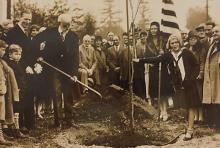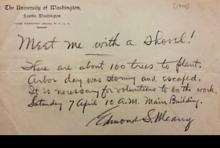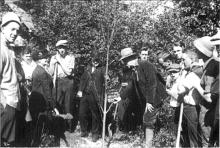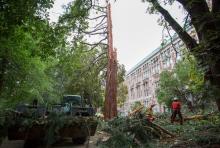A recent lightning strike forced the removal of the grand old sequoia near the northeast corner of Smith Hall. The tree was known to many as the "Meany sequoia," after the man believed to have planted it, Edmond Meany. In truth, it is difficult to document the tree's connection with Edmond Meany, but the attribution is widespread and entirely credible. In fact one of Meany's great legacies to the university is the variety and richness of the campus's trees. A count of the rings indicates the sequoia was about 104 years old, confirming that it was planted at the height of Meany's time as the university's unofficial chief arborist.
Edmond Meany was a polymath, perhaps best remembered as the founding father of the UW Department of History. He began his UW career as an undergraduate in the class of 1885, and over the years earned multiple degrees and occupied a number of positions at the university. In 1897 he was appointed as the university's first professor of history and head of the nascent Department of History. From then until his death in 1935, Meany was a UW fixture, beloved as a teacher and respected as a trailblazing historian of the Native Americans and pioneers of the Northwest. Always an advocate for the importance of history, his leadership laid the foundations upon which the UW would build the department into a world-class program.
Edmond Meany was not simply a man of letters, however. He was just as fascinated by the region's natural history as by its human history. He regularly taught courses on forestry at UW, led groups of students on hikes and botanical expeditions, helped to organize the Young Naturalists' Society on campus, and held executive positions in forestry associations at both the state and national level. Not content simply to go and experience nature, Meany also sought to enrich the natural resources of the university. He imagined the UW as a site for outdoor relaxation, botanical study, the propagation of exotic species, and the development of more efficient horticultural techniques. Always careful to refer to the UW campus as the "university grounds and arboretum," Meany turned his home near the present-day University Tower into a nursery for thousands of seedlings, and went on to plant hundreds of trees on the university campus, representing dozens of species.
After more than a century of campus construction and renovation, the Meany sequoia was one of the few trees left at UW that are believed to have been planted by Meany himself. Sadly, on Saturday, September 5th, the tree was struck by lightning. The bolt cleaved it all the way to the ground, scattering fragments as far as Suzzallo Library and the southeast corner of Thompson Hall. The ferocity of the strike made it difficult to salvage large pieces; however, the UW carpentry shop has saved smaller pieces for use in projects such as awards and plaques.
Though visitors to Smith Hall will no longer be able to enjoy the sight of this majestic giant, the larger vision of Edmond Meany lives on at the UW, not only in the Department of History but all over campus. The great diversity and verdancy of the university's trees are a direct result of the vision and hard work of Edmond Meany and those he inspired. You can be a part of this legacy as well, and you don't even need to grab a shovel—simply stop for a moment to appreciate the trees the next time you stroll across campus.
-- Eric Johnson




